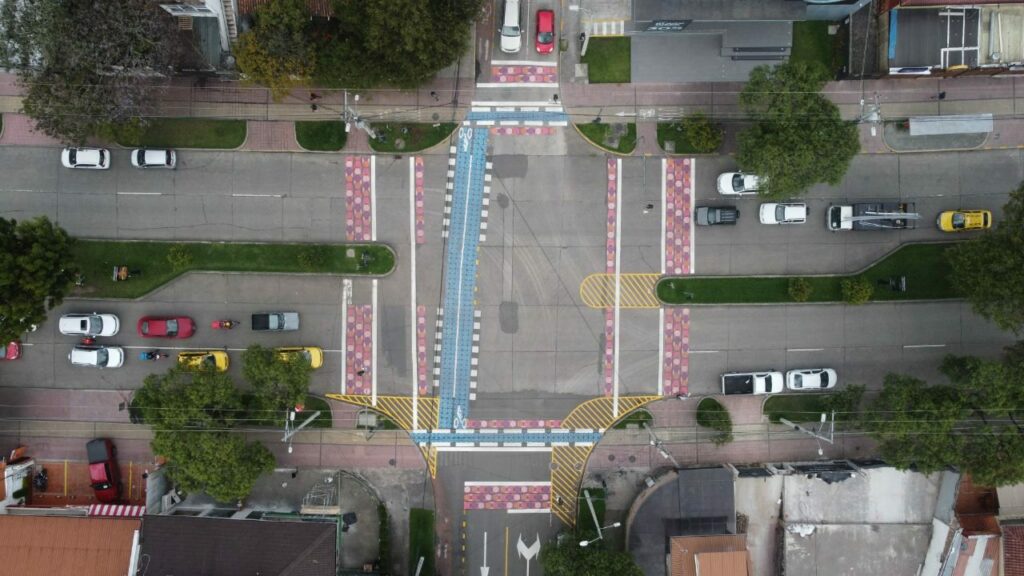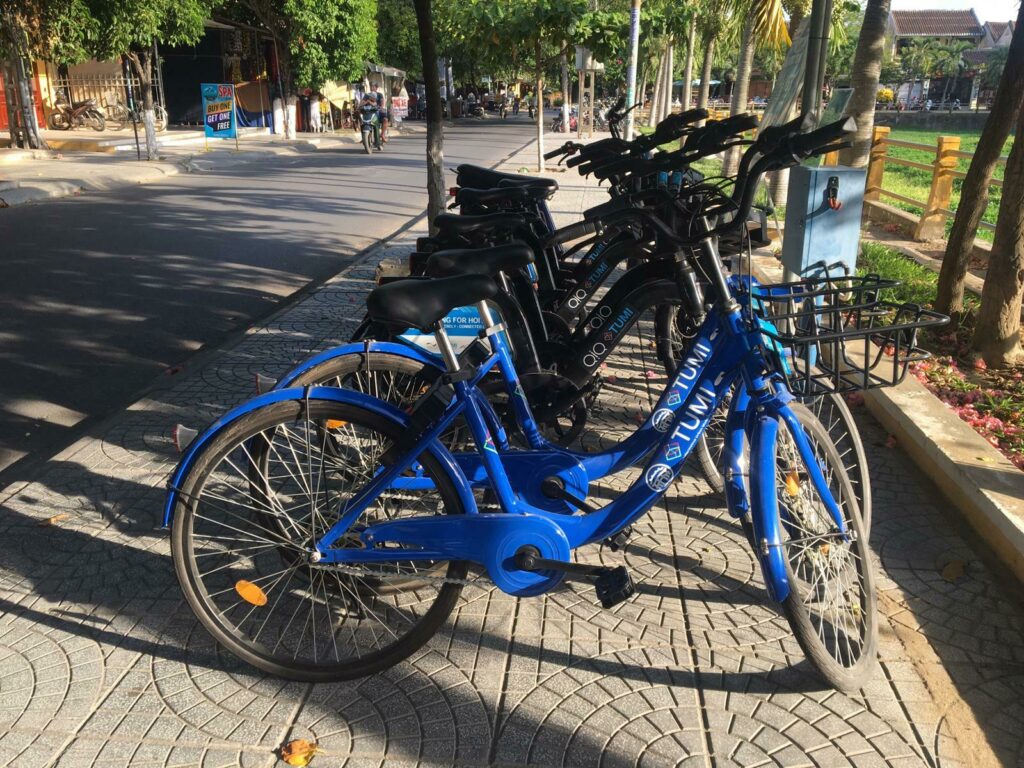By Bahar Melisa Yildiran
Although it was invented over 200 years ago, the bicycle has grown immensely in popularity since the outbreak of the coronavirus pandemic and advent of the e-bike. Proven reliable and safe, cycling has a transformative potential for transportation in the areas of decarbonization, health, safety, and citizens’ well-being, as many cities around the world have witnessed.
Countries like Denmark and the Netherlands have proven that to get people on bikes and create a successful cycling culture, you need safe and protected infrastructure together with complete stakeholder integration. TUMI defined several steps needed to transform deeply ingrained behaviors by investing in the future. Cities all over the world have benefited from TUMI’s support in enabling and promoting cycling in their communities and through these TUMI Challenge projects, we’ve identified five easy and successful approaches to create a safe environment for cyclists. These pilot projects, an effective tool to draw the public’s attention to the kinds of improvements that may be done in communities, raise public awareness and can instigate change.

-> Download the TUMI Strategy Spotlight – 2 km Cycling Lanes Per 1000 Inhabitants
1. Improving cycling conditions to combat crises
As COVID-19 affected not only our healthcare systems and economy but transportation as well, TUMI worked with partners in cities around the world to develop mobility solutions that improve the resilience of urban transportation networks. While some of the selected cities already had an existing bike network that needed to be expanded to meet increased demand and to get closer to the goal of 2km of safe and protected bicycle infrastructure per 1000 inhabitants, others used the crisis to restart their bike infrastructure. TUMI ignited the creation of safe, reliable, and permanent urban bicycle networks.
The need for non-motorized transportation that arose with the pandemic led to changes in the cycling system and infrastructure in Cuenca, Ecuador. Working in partnership with the municipality and GIZ, for the TUMI Challenge Cuenca, the Copenhagenize Design Co team consulted at four key crossroads. They brought a user experience perspective to the design process and created an implementation guide for safer streets. Based on the training and guidelines, two cycling intersections were implemented which will be replicated in other parts of the city. Cuenca is getting closer to its aim of hosting a sustainable and safe urban cycling system, while offering residents a resilient mobility option that extends beyond times of crisis, thanks to the new bicycle infrastructure. Designers and authorities have now understood that the bicycle can offer a quick solution in a crisis. The torch has been lit to incorporate cyclists, who are frequently ignored, in the designs we want to see in cities.

The city of Belo Horizonte likewise set out to implement a human-centered design of the city districts, looking from a different perspective at changing the infrastructure facilities for cyclists. The EcoZone Santa Tereza Project addressed sustainable mobility in a project with partners World Resources Institute, Wuppertal Institute, the city of Belo Horizonte, and UN Habitat, which made the importance of public spaces to enable social public life more evident. For this purpose, 30 km/h speed zones were piloted in various parts of the city, and the bicycle path network was analyzed and expanded. The attention created by this TUMI Challenge revealed the possibilities for cost-inexpensive socializing and options for increasing safe transportation.
2. Creating positive attitudes towards urban cycling
The urgency and need to change transportation that the COVID-19 pandemic instigated has escalated very quickly in many cities. The city of Trujillo, Peru used the opportunity brought on by the epidemic to redistribute in favor of cyclists and pedestrians with TUMI and Transporte Metropolitano de Trujillo (TMT). Though the environmental conditions in Trujillo are ideal for cycling, cyclists are discouraged by the lack of cycling infrastructure. Providing a safe and flexible mobility option for citizens and creating a positive impact are thus seen as important pillars of the project.
To enhance awareness of the benefits of cycling, 413 stakeholders were trained to promote the use of non-motorized transport. To showcase cycling as an affordable, accessible, and efficient mode of transport, 1000 cyclists joined the ride to create awareness of cyclists on the road. Through the example of Trujillo, we can see the transition towards a sustainable transportation system focusing on high-quality active mobility prepared and directed.

©Transporte Metropolitano de Trujillo (TMT)
3. Investing in future cyclists
Schoolchildren who live in an unsafe urban environment lack active mobility options and face a high rate of traffic accidents. Working with children in a car-centric environment demands early education in safety. To create the cyclists of the future, proper walking and cycling infrastructure near school buildings are essential. “Get to School Sustainably” is an infrastructure and capacity building project in the public school system in Zhytomyr, Ukraine, carried out in partnership with GIZ. This pilot project, mainly aimed at (re)building sidewalks near the school, creating safe pedestrian crossings and preparing guidelines for cycling to school, is a pioneering project in the city. By improving the infrastructure around four selected pilot schools and the participation of 28,304 students in a modal split study, an investment has been made in the cyclists of the future and therefore in a sustainable world.
-> Download the guideline on School Mobility: Improving Safety and Comfort of Students Traveling to School | Transformative Urban Mobility Initiative (TUMI) (transformative-mobility.org)
4. Bike Sharing: Piloting A Public Scheme
Bike sharing programs can be an important part of transportation strategies as they lay the foundation for a long-term cycling vision. To encourage cycling among residents of Hoi An, Vietnam, the city focused on developing a joint bicycle plan as a mode of transportation for residents and visitors alike. Support for the development of the Bicycle Transport Development Plan and the introduction of the first Public Bicycle Sharing Plan (PBS) in Hoi An showed that reducing barriers to cycling could increase the number of cyclists, which would increase political support and public interest in broader cycling improvements. Actions identified on bicycle development were considered by HealthBridge Canada, WRI, GIZ, and TUMI during project implementation.

Carrying out non-motorized traffic will contribute to achieving a city that is both ecological and high on cultural tourism.
Mr. Nguyen Van Lanh, Head of Culture & Information Department of Hoi An City
The growing awareness of residents and the Hoi An Authority has become a starting point for expanding projects to improve cyclist safety. This successful planning demonstrates that partnerships with additional companies from the private sector are possible and have considerable potential, as do projects in other cities in Vietnam and neighboring countries.

5. Establishing a network of cycling experts and advocates
Even in cities with no existing bicycle infrastructure at all, the transition towards more cycling-friendly neighborhoods is possible and has been demonstrated by the TUMI Challenges.
In 2018, the City of Addis Ababa, Ethiopia saw the potential in establishing the bicycle as a safe, inexpensive, and reliable mode of transportation as a means of tackling growing traffic and congestion concerns in the fast-growing city. For the city to meet its lofty objectives, they gathered a group of advocates, specialists, and decisionmakers; the TUMI Team, in partnership with ITDP, shared the risks and guided the AATB (Addis Ababa Transport Bureau). Bringing together the stakeholders resulted in the design and launch of the city’s ambitious long-term cycling vision.
The process of introducing cycling to the city focused initially on safety and awareness. In addition to the preparatory work for active mobility and the development of the NMT Strategy, workshops and trainings were used to develop tailored framework for mainstream cycling activities. Leading the change was the Addis Ababa Transport Bureau, headed by Dr. Eng. Solomon Kidane, with the entire team coordinating the expertise from the international partners throughout the responsible City Bodies. The city’s pilot project successfully demonstrated to city decisionmakers that change is possible. Witnessing the change and continued support by TUMI Partner, WRI, the Transport Ministry was convinced by the importance of active mobility, and – for the first time – cemented ambitious cycling targets in the National Transport Strategy of 2020. Based on Addis Ababa’s success, further African cities have adapted the approach and a successful inter-continental expert exchange was initiated.
Making A Lasting Impact On Cities
As we look ahead to the coming year and reflect on past experiences, it’s clear that cycling should be integrated into the city as much as feasible ‑ with permanent solutions that make cycling both a safe and attractive means of transportation for now and after the pandemic. Every city enters the process of transformation from a different starting point: Cycling culture can take on a unique form in different places, and there are multitudinous ways to start change.
The backbone of the transition towards cycling-friendly cities consists of protected, continuous networks of bicycle infrastructure (ideally 2km/1000 inhabitants), citizen engagement to create positive attitudes towards active mobility, education of children and adults, and last but not least, the cooperation with experts, innovative entrepreneurs, and the local economy.
With these principles in mind, the TUMI Challenges have succeeded in their aim to grow the transition to cycling as a sustainable mobility option. These projects have created a lasting “TUMI Effect” that changes people and cities for health, environment, air quality, economic impact, livability and accessibility.